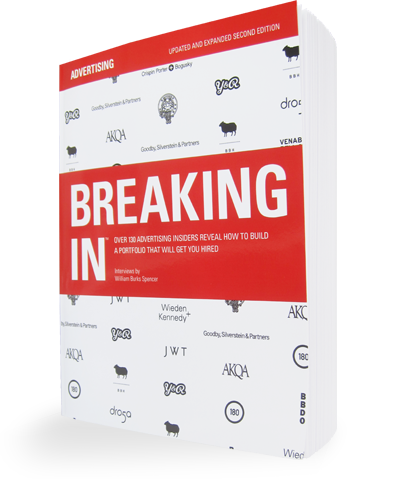Check out some great work from Mitchell Ratchik.
What do you look for in a student or junior book?
A student book should be a work of love. This is before you’ve actually “produced” anything or had clients or CDs alter your work. That being said, competition is fierce! I personally look for good thinking above all. I put on a second lens for art directors; they need to demonstrate good type and layout abilities. I’m more forgiving with writers. The best ones solve a problem using a unique perspective, and then they execute it well. A student book should be an extension of your personality and aesthetics.
Common problems and things to avoid?
The first big mistake students make is putting work in that they’ve actually “produced” but doesn’t really reflect their best thinking. My advice is “Don’t do it.” I’d rather see smart thinking and the ability to come up with a visual vernacular than some lame ad that actually ran. Also: be focused! The second big mistake is books that have a little of everything, but no focus. If you’re going into advertising, you need ads. It’s okay to show some other stuff as well, but the focus needs to be advertising.
How important is the level of finish? Could sketches be enough?
Finish is very important. For art directors, it’s essential. Nothing makes me angrier than an art director who can’t design or has no understanding of type, color, and layout. I don’t want to hear it; go back to school and do the work. There is just no excuse. Some might say that’s harsh and art directors direct and are not responsible for designing. My response to that is: you have no idea what you’re talking about. Junior art directors are in the trenches and are expected to execute! There is no excuse now that everyone has computers and can make their comps tight. And writers need to make an effort to find an art director to help them lay out their ideas. Make a flyer and post it up.
Sketches are great when you are concepting. I personally forbid my students to use the computer during the concepting phase. Get the idea first, then execute. I always use the hallway/room metaphor. Every idea is a room. Don’t just walk into one room and stay there. Walk down the hall, peek into all the rooms, and then go back and explore the ones that looked good.
[ … ]
Other advice about portfolios or getting into advertising?
Keep your book to about seven to eight campaigns. Only put the best thinking in. You are your best critic. Be extremely harsh on yourself. Get lots of different opinions. Show your friends; if they keep telling you how great everything is, wake up—they’re not your friend! They are just blowing smoke up your tuchus. Get real criticism and never be satisfied. Your book will and should evolve with you.
As for getting your foot in the door…by any means necessary. Get an internship, work the mailroom, work as an assistant (I know several very successful creatives that came in that way). And most important: don’t give up. When showing your book, look for real feedback. If you didn’t get the job, follow up and ask them how you can improve your book.


One Response